
BLOG ..BLOGUE
News from SouthWest ..Des nouvelles du Sud-Ouest
A Word From Douglas Hastie
The last federal government wage subsidy program ended on May 7 of this year. The first one started on March 14, 2020. During this period, SouthWest United benefitted from four different federal programs.
The various programs were introduced to help registered charities, among other entities, survive during the ongoing coronavirus pandemic. The subsidies represented reimbursement of a portion of the church salaries paid between March 14, 2020 and May 7, 2022.
Between March 14, 2020 and October 23, 2021, SouthWest received $44845.71 from the Canada Emergency Wage Subsidy (CEWS) program. Between October 24, 2021 and May 7, 2022, SouthWest received $1257.29 from the Canada Recovery Hiring Program (CRHP) and $7942.15 from the Tourism and Hospitality Recovery Program (THRP).
SouthWest benefitted from the temporary Emergency Wage Subsidy (TEWS). This program started on March 18, 2020, and ended on June 19 of the same year. SouthWest received $1755.51 from the TEWS program. It represented 10% of the church salaries paid during the qualifying period.
During this same period of time the Quebec government offered us no programs of assistance.
SouthWest United Church is grateful for the federal government support during these months as we struggled to survive. Despite not being able to enjoy our normal activities, we have managed to continue to pay our employees as they continued to work. There is no doubt that the monies received enabled SouthWest to survive as long as it has.
Summary of amounts received
CEWS $44845.71
THRP 7942.15
CRHP 1251.29
TEWS 1755.51
Total $55800.66
August 1st is Emancipation Day!
On June 19th, our American neighbours celebrated Juneteenth, a day that celebrates the emancipation of enslaved African Americans in 1865. Proclaimed a federal holiday by President Joe Biden last year, Juneteenth got quite a lot of attention, even in Canada. A federal holiday of our own was also made official in 2021: Emancipation Day is celebrated on August 1st, but many Canadians still don’t know what it’s all about.
There are still people in this country who believe that we never had slavery here. Technically, we didn’t have slavery in Canada, but only because “Canada” came into being in 1867, after slavery was abolished in virtually all the colonies in the Americas. But that doesn’t mean there weren’t enslaved people on this territory when it was called British North America, or before that, New France.
It's easy to tell ourselves that slavery was a Southern institution, that the Northern British colonies, including those in present-day Canada, were opposed to it. In fact, the Abolitionist movement only got going in the late 18th century, 200 years after the first settlements were established in the New World by English, French, Dutch, Spanish and Portuguese colonists. All of these empires participated in the transatlantic slave trade which began around 1500.
It is fair to say that we didn’t have slave ownership in the same numbers in Canada as they had in the United States, but that is a far cry from having none. And surely even one enslaved person is too many.
Although France prohibited slavery on its own shores, in 1688, Louis XIV granted New France’s petition to begin importing people from West Africa as slaves. Although no shipments ever actually came directly from West Africa to Nouvelle France, colonists here acquired slaves from other French and British colonies.
Britain was similar: it was not very common to see enslaved people in the mother country, but the British empire was built on the backs of enslaved people working on cotton, sugar and tobacco plantations in the Caribbean, North and South America.
Well before the British conquered the French in North America in 1760, there were already many people living in slavery in New France. Some were of African descent; others were Indigenous.
As Canadians, we may decide that June 19, 1865 is not a significant date for us (although there are many Canadians who are descended from former American slaves), but we might want to pay attention to a few other dates:
In 1794, Revolutionary France abolished slavery throughout its empire, only to have it reinstituted by Napoleon in 1802. (Haiti declared itself independent from France in 1804 and became the first country in the Americas to abolish slavery). The French re-abolished slavery throughout their empire in 1848.
Britain (and the United States) outlawed the international slave trade in 1807, meaning they would cease the practice of kidnapping and enslaving free African people, but this law made no change to the status of the hundreds of thousands - maybe even millions- already living in slavery in British colonies. (Several Northern states and the province of Ontario did outlaw or limit slavery in the late 1700s).
In 1833, Britain abolished slavery throughout its empire including in British North America.
This is our history of slavery. It was legal and existed in much of what we now call Canada and Quebec from the earliest settlements in the 1500s up to 1833. We got the jump on abolition over the United States by about 30 years. That’s hardly a source of bragging rights, and a far cry from the erroneous claim that we never had slavery here.
The Slavery Abolition Act came into effect throughout the British empire on August 1st, 1834. This August 1st, we should go ahead and celebrate 188 years since emancipation, as long as we recognize the history of slavery, right here at home, that necessitated an act to abolish it.
August 1st is not just a Canadian holiday. Emancipation Day is celebrated throughout the former British Empire. In 1985, Trinidad and Tobago became the first country to officially declare it a national holiday .
The internet has lots of resources to learn more. Here are just a couple: Montecristo Magazine ; Canadian Heritage
Image: Black Canadians celebrate Emancipation Day in Amherstburg, Ontario in 1894. Photo by Andrew Merrilees/Library and Archives Canada.
Mary the Tower
I am always looking for those things which may be hidden, especially when it comes to the Gospels.
For some years now I have been following several Christian biblical historians whose insight plants those seeds which germinate and take on a life of their own and, in the process, open us up to the possibility that the teachings of Jesus may have indeed been manipulated to fit the times in which they were translated. Or, perhaps even more disturbing, that they were deliberately changed for political or personal gain. Whether or not there could be truth to those suspicions, every so often I come across an article that is just too precious not to share.
A few weeks ago, our Sunday reading focused on the story of Martha and Mary. Below are the thoughts of Diana Butler Bass which are just too interesting to pass up sharing with you.
Enjoy the possibilities.
Pastor Beryl, DLM
ALL THE MARYS
Wild Goose Festival Closing Sermon, July 17, 2022
by Diana Butler Bass
[listen to audio version: ]
Good morning.
I begin with today's Gospel reading from the Revised Common Lectionary, a book of readings shared widely by churches across the world. This text comes from Luke 10, versus 38 through 42. "Now, as they went on their way, he entered a certain village where a woman named Martha welcomed him into her home. She had a sister named Mary who sat at the Lord's feet and listened to what he was saying, but Martha was distracted by her many tasks. So she came to him and asked, 'Lord, do you not care that my sister has left me to do all the work by myself? Tell her to help me.' But the Lord answered her, 'Martha, Martha, you are worried and distracted by many things. There is need of only one thing. Mary has chosen the better part, which will not be taken away from her.'"
Hear what the spirit is saying to the world.
Now, this story, for those of us who are churchgoers and for people who may not have been in church or don't go to church very often, is actually a familiar story. A lovely, charming tale about Jesus and his encounter with two sisters: busy Martha and contemplative Mary. This text on its own would be a great way to end Wild Goose. Over the last four days, we have heard a lot about what we need to do. We are worried that there are so many tasks at hand. I can imagine leaving Goose and being Martha. Work, work, work, because the time is short, we have to get it all done. But there's Mary.
And what could be the message here is the invitation into what Jesus calls, "the better part." Mary is sitting at Jesus' feet, contemplating, listening, receiving the teachings of Jesus. Thus, we have the charming tale, Martha, the doer, Mary, the listener, and Jesus saying, "Mary has chosen the better part." That's the sermon that I'm NOT going to preach.
Instead, my sermon is called, “All the Marys,” and the faith that we have been seeking. In order to enter into the point of this text today, I want to begin with just a short story from my own experience about my daughter. My daughter Emma was born in 1997. And when Richard and I got married, we had just seen what was then the new version of Emma, the film based on the Jane Austen novel. We loved it. And we found out we were having a baby girl and we immediately knew we wanted to name her Emma!
What we didn't know is that Emma would wind up being one of the most popular names for girls born in 1997. As Emma was growing up, when she went to school, there were a plethora of Emmas. Indeed, we sent her to a small independent school for elementary school and middle school, and there were three — three — Emmas. There were three Emmas in her class of some 25 people. For the rest of her elementary school career, she would be known as Emma B., as opposed to Emma P., as opposed to Emma S. Throughout elementary school, we would get the wrong notes, we would get the wrong assignments. People would talk about Emma, and they would say, "Oh, Emma did X, Y, Z," and it was, which Emma? Which Emma are you talking about?
And that's exactly where this text today should take us. When we hear the story about busy Martha and contemplative Mary, a question that we might not think to ask but one that we should ask is, which Mary? Which Mary is this? You might think you know. Indeed for many years, I thought I knew. I have preached any number of sermons at churches all across North America about how this Mary and Martha story is related to another story. A story in John 11, a story about Mary and Martha, the sisters of Lazarus who live in a place called Bethany. Indeed, if you go to many commentaries on the Luke 10 passage, on the Mary and Martha story, those commentaries begin by saying, "This is a story of Mary and Martha, the sisters of Lazarus, Mary and Martha of Bethany."
But if you actually look at the Bible — which would be a good idea, especially for someone who is writing a commentary — you will see that the words "in Bethany" are never mentioned in Luke’s text. Indeed, if you look at a map, Bethany is actually a town, a village in the opposite direction of which Jesus was traveling in this section of the Gospel of Luke. All Luke says is that Mary and Martha were of a “certain village.” Then there’s an interesting identification of Martha where it says, "Martha welcomed Jesus to her home." And what's fascinating about just that little phrase, just that small phrase, Mary and Martha are sisters in a patriarchal society. If they had a brother, that line would say, "And Martha welcomed Jesus to her brother's home," because Martha doesn't own a house. It's not Martha's home unless it is Martha's home. The only way it's Martha's home is if Martha has no husband, no father, and no brother.
Many readers conflate Luke 10 with John 11, where there are two sisters named Mary and Martha, and they have a brother named Lazarus, and they do indeed live in a place called Bethany. If it was the same family, Luke 10 is very confused. The village is in the wrong place and it's not called by the right name. What we actually have here is two stories that our imaginations have run together, which our tradition has run together, which even commentators have run together. These are actually two different stories about two different families. This is as if people came home from school and said, "Emma Bass did something, something, something," and it was actually Emma Presing.
It becomes a problem when you get the cast of characters wrong. So the question is: who is this Mary? Instead of spending a lot of time talking about Mary of the four short verses in Luke, I want to run over to the confused text of John 11. John 11 opens with a very simple sentence. "Now a certain man was ill, Lazarus of Bethany." Okay, now there we have it clearly defined, Bethany, not a certain village. "The village of Bethany, the village of Mary and her sister, Martha." That's the opening sentence of John 11. You might think to yourself, oh my gosh what is the big deal, what's important about that?
Let me tell you the story of my friend Elizabeth Schrader, who is a PhD student at Duke University right now working on a doctorate in New Testament studies.
Years ago, Elizabeth (her nickname is Libbie) was living in New York City where she was a singer-songwriter. Libbie is a cradle Episcopalian with a very lively faith life. She adores the church. She loves liturgy. She loves praying with and to the saints. And one day Libbie walked into a church garden in the city of New York seeking refuge from the city, and sat down to pray. And as she prayed, she heard a voice and the voice said, "Follow Mary Magdalene."
Now, Libbie usually doesn't hear voices when she's sitting in gardens praying. This was pretty startling to her. And she wrote a song about this. It's actually called “Magdalene.” And that's what happened. She wrote an incredible song about Mary Magdalene. But then something deeper started nagging at Libbie. And she thought, "Well, I don't think I was just called to write a song. I think I need to learn more." And so here she is, an Episcopalian living in New York City, and she thought, "Where do I learn more about the Bible?" And she calls up General Theological Seminary in New York City, which is the Episcopal seminary there, and she says, "I need to learn more about Mary Magdalene. How do I do that?"
I have no idea what the person in the admissions department said exactly to her, but they did tell her that she could come to General and that she could earn a degree, a master's degree in New Testament if she liked. And she said, "Oh, I want to do that. I feel called to do that." And so Libbie signed up for the New Testament program where she studied with a wonderful New Testament professor who taught her Greek and Coptic and Aramaic, and all the stuff, and began to teach her how to translate the New Testament. And Libbie was off to the races as a master's degree student in New Testament. She couldn't get Mary Magdalene off of her mind. When it came to writing her final paper for her master's degree, she asked Dierdre Good (the professor) if she could write it on John 11 and Mary Magdalene. And Deirdre said, "Absolutely." And then she said, "Do you know that these texts have lately become available digitized? And so if you want to study Mary Magdalene, I want you to look at the earliest possible New Testament texts and try to say something new about them."
And so Libbie looked at Papyrus 66, which is the oldest and most complete text we have of the Gospel of John. It's dated around the year 200. Now this is what happens when you put a set of new eyes on an old text, Papyrus 66 had been sitting in a library for a very, very, very, very long time. We've had it for a while, but you had to go to it in order to see it. But Libbie was sitting in a library in New York City and Papyrus 66 came to her. This is an historic moment in New Testament studies. When any one of us could have access to texts that have been only be used by people if they had a lot of money, a lot of degrees, and a lot of time to travel.
And so Libbie is in the library looking at the text and she sees this first sentence. And it's in Greek, of course. "Now a certain man was ill, Lazarus of Bethany, the village of Mary and his sister Mary." And Libbie said, "What? That's not what my English Bible says. My English Bible says, "Now a certain man was ill, Lazarus of Bethany, the village of Mary and her sister, Martha." But the Greek text, the oldest Greek text in the world doesn't say that. The oldest Greek text in the world says, "Now a certain man was ill, Lazarus of Bethany, at the village of Mary and his sister, Mary." There are two Marys in this verse. And Libbie went, "What the heck? What is going on here?" And she started digging into the text, zooming in on it to try to see what she could see over the digitized version in the internet. And lo and behold, Libbie noticed something that no New Testament scholar had ever noticed.
And that is, in the text where it had those two Marys, the village of Mary and his sister, Mary, and her sister, Mary, the text had actually been changed. In Greek, the word Mary, the name Mary, is basically spelled like Maria in English, M-A-R-I-A. And the I, the Greek letter I, is the letter Iota. And it looks basically like an English I. Libbie could see by doing this textual analysis that the Iota had been changed to the letter TH in Greek, Theta. That somebody at some point in time had gone in over the original handwriting and actually changed the second Mary to Martha. And not only had that person changed the second Mary to Martha, but that person had also changed the way it comes out in English. It says, "The village of Mary," that would've stayed the same, "and her sister, Martha." Someone had also changed that “his” to "her" that "her" was originally a "his", but they had changed it to a "her".
Admittedly, the original text is a confused and not very good sentence. "Now, a certain man was ill, Lazarus of Bethany, at the village of Mary and his sister, Mary," it's almost like they're heightening the fact that Lazarus has this sister, Mary. They lived in this village together, and Mary is Lazarus' sister. Someone had changed it to read, "Mary and her sister, Martha."
Libbie sat in the library with all of this, and it came thundering at her, the realization that sometime in the fourth century, someone had altered the oldest text of the Gospel of John and split the character Mary into two. Mary became Mary andMartha.
She went through the whole manuscript of John 11 and John 12, and lo and behold, that editor had gone in at every single place and changed every moment that you read Martha in English, it originally said, "Mary." The editor changed it all. So that the story becomes a charming story about Lazarus and the resurrection and his two lovely sisters, Mary and Martha. Haven’t we seen them before? Oh yeah, I remember seeing them in Luke 10.
But they are not in Luke. This is some editor's idea of doing what Pete Enns told us this morning. Harmonizing the text did not just start a couple hundred years ago. Somebody in the fourth century decided that John was confusing and this John fellow had bad Greek. And so the editor went in there to fix it. And he fixed it. He fixed it so good that we have been telling this story wrong ever since.
Every pronoun is changed. Every singular "sister” is changed to the plural "sisters". And Libbie has conclusively proven that in Papyrus 66 this fiddling around with the text did indeed occur. Now, if you can imagine this, finding this as a master's degree student when you have just barely learned Greek is an amazing sort of discovery. Libbie wrote her master's thesis on it. It was so interesting as a master's thesis as she proved this textual manipulation that Harvard Divinity School found out about it. And they said, "Can we excerpt your master's thesis and turn it into an article?" And so here's this brand new master's and New Testament student who gets her very first ever professional article published by the Harvard Theological Review.
From there, many scholars noticed her article -- including the Nestle-Aland Translation Committee of the Greek New Testament, an organization that is located in Germany. These are the guardians of the Greek New Testament. They are as stuffy as you can imagine. They are basically a whole bunch of very old German men who have spent their entire lives making sure the Bibles that we have in English and all the other languages around the world are the closest and most precise Bibles that we can get to the original manuscripts. They asked Libbie to come to Germany to present her research to them. And over the course of a couple days, they listen to her and they look at all the evidence that she's compiled. And at the end, they say, "Well, we might need to change something here."
As we are speaking, there is a debate going on in the highest circles of New Testament studies as to whether or not Libbie's research should turn into a very long footnote that all you preachers will be reading in your next edition of the New Revised Standard Version of the Bible in English. Or if they should change John 11 and John 12 and take Martha out. Now, that is probably one of the most radical suggestions I have ever heard in New Testament criticism. And, of course, in order to take Martha out they wanted more evidence. (I just heard some people yelling in the back of the auditorium, "Don't take Martha out.") Everybody always says, "I love Martha in Luke chapter 10."
But these are two different stories. These are two different families. Martha will stay forever in Luke 10. She's lovely. She’s important. Jesus loved her. She stays there. But she shouldn't necessarily be here – in John 11 and 12.
And so people have begun to do other research pursuing and extending Libbie's work. Including other New Testament scholars and church historians.
Tertullian, one of the most misogynistic of all of the ancient church fathers, actually wrote a bit of a commentary on this passage in John chapter 11. He writes circa 200. Commenting on this chapter, he says, "Mary, confessing him, Jesus, to be the Son of God."
Wait a second.
In my Bible, it says Martha confessed that. It says a little later on that Jesus was talking to Martha. Martha said to Jesus, "Lord, if you had not been here, my brother would have died. But even now I know that God will give you whatever you ask of him." And Jesus said to Martha, "Your brother will rise again." And Martha said to him, "I know that he will rise again in the resurrection on the last day." And Jesus said to her, "I am the resurrection and the life." One of the most important lines in the whole of the Gospel of John. "Those who believe in me, even though they die, will live. And everyone who lives and believes in me will never die. Do you believe this?" Jesus asked this woman. And in this text, your English Bible, Jesus says that to Martha, "Do you believe this, Martha?" And she said to him, "Yes, Lord. I believe that you are the Messiah. The one who's come into the world."
Tertullian said that was Mary. There was no Martha in that passage according to Tertullian. Did Tertullian’s copy of John have only Mary?
And what about how that passage begins with a story about how Martha runs out to meet Jesus, but Mary is so upset that poor Mary stays home because she can't possibly face Jesus? Egeria, a fourth century Pilgrim to the Holy Land, writes in her diary — which is one of the most important diaries we have from the ancient world from any ancient Christian — about her pilgrimage group getting to the church in the place where Mary, the sister of Lazarus, ran out to meet the Lord. Tertullian doesn't mention Martha. In Egeria’s diary, there is no mention of Martha. Indeed, in these ancient sources, the story is a story of Mary.
John 11 is about Lazarus and one woman, one sister, Mary.
Now the most provocative question is, well, why did this editor split Mary into two women? Perhaps the editor could have been a guy with literary sense and he just didn't like John's Greek and so he fixed it in a way that made sense to him. Or he could have been a person who was just a little worried about how this story fit with Luke’s story? Maybe it makes more sense if it's a story about Mary and Martha and not just a story about Mary. So that person could have had benign motives.
Or not.
That little text from John 11, that I just read to you, is one of two Christological confessions in the Gospel. Another of those Christological confessions happens in the synoptic Gospels. It happens in Mark. It happens in Luke. And it happens in Matthew. Who utters the Christological confession in those three gospels? Anybody remember? Peter, exactly. Peter and Jesus have a conversation. And Jesus turns to Peter and says, "Who am I?" And Peter actually says, "You are the Messiah, the son of the living God." And Jesus turns around and says to him, "You are Peter, upon this rock I will build my church."
The other Christological confession is in the Gospel of John. And until this point, it has belonged to a minor character named Martha and we didn't even know who she was. Jesus raises her brother from the dead and they have this conversation. And then finally this woman says, "Yes, Lord. I believe that you are the Messiah, the son of God, the one who is coming into the world." Pretty much exactly the same words that Peter has uttered in the synoptic Gospels. And then Martha disappears from history. Unimportant, unremembered, who is this?
But if it is Mary, the Mary who shows up in John 11 is not an unremembered Mary. Not just one of a plethora of Marys in the third-grade class. This Mary has long been suspected of being the other Mary, Mary Magdalene. Is it really true that the other Christological confession of the New Testament comes from of the voice of Mary Magdalene? That the Gospel of John gives the most important statement in the entirety of the New Testament, not to a man, but to a woman, and to a really important woman who will show up later as the first witness to the resurrection.
You see how these two stories work together. In John 11, Lazarus is raised from the dead, and who is there but Mary Magdalene? And at that resurrection, she confesses that Jesus is indeed the son of God. And then you go just 10 chapters later and who is the person at the grave? She mistakes him, at first, thinks he's the gardener. She turns around and he says, "Mary," and she goes, "Lord." It's Mary Magdalene. It is Mary Magdalene.
Now you might say to yourself, I thought she was from Magdala and not Bethany. What is this Bethany place? That's the last bit of biblical scholarship I want to let you in on this morning.
There is an important debate going on right now about where Mary Magdalene is from. A lot of people, especially if any of you have ever been to the Holy Land, you might have gone to the little village that's right on the sea of Galilee. And there's a church there, the church of Mary Magdalene. And some very nice tourist guide has said to you, "This is the place that Mary Magdalene's from." But there's a really weird problem with that. That village wasn't known as Magdala in the first century, and so that's something they forget to tell you on the tour. And nobody is quite sure where that village would be if there was a village called Magdala. Instead of Mary being from this nice fishing village, there is good evidence to suggest that she was from somewhere else. And this text begins to suggest she is from Bethany.
Magdala, when we call her Magdalene, Mary Magdalene, is not Mary from Magdala. Instead, it's a title.
The word magdala in Aramaic means tower. And so now you get the full picture. In the Synoptics, Jesus and Peter have a discussion. In that discussion, Peter utters the Christological confession. As a result of the Christological confession, Jesus says, "You are Peter the Rock." In the gospel of John, Mary and Jesus have a conversation, and Mary utters the Christological confession. And she comes to be known as Mary the Tower.
Between these two confessions, are we looking at an argument in the early church? Peter the Rock or Mary the Tower?
But the John account was changed. The John story has been hidden from our view. All those years ago, Mary uttered those words, "Yes, Lord, I believe you are the Messiah, the son of God, the one who is coming into the world."
When Libbie told me of her research, and this story of the confession, we were sitting in a Starbucks in Alexandria, Virginia. I started to cry and I couldn't stop. She had just told me a story that I always intuited existed. When she told me the pieces and how they fit together, and as soon as she said, "Mary the Tower," I said, "I know. I know this to be true. This is the truest thing I have ever heard about the Gospel."
Mary is indeed the tower of faith. That our faith is the faith of that woman who would become the first person to announce the resurrection. Mary the Witness, Mary the Tower, Mary the Great, and she has been obscured from us. She has been hidden from us and she been taken away from us for nearly 2,000 years. This is not a Dan Brown novel. This is the Nestle-Aland Translation Committee of the Greek New Testament. This is the Harvard Theological Review. This is some of the best, most cutting edge historical research in the world. And we are living in the moment of most radical transformation in the understanding of the Gospel accounts, of who Jesus Christ is, and who holds authority.
The Feast day of Mary Magdalene just happens to be this coming Friday (July 22). Celebrate Mary Magdalene with abandon. Celebrate this story that I just shared with you – celebrate all the Marys. Don't mix them up. Don't mix them up. We can leave Wild Goose and be thinking of the lectionary text about Mary and Martha -- and it is a beautiful text, and it is a charming story. I'm not getting rid of Martha from Luke. For those of you who have identified with Martha over the years, nobody's taking away your Martha story. It is still a meaningful story of activism and contemplation. And it has a lot to do with what we have just gathered here to do over the last four days. You can take that message with you, hold it in your heart, and know that the scripture speaks to it. Take rests as you're working towards justice.
Or, or perhaps and, you can leave here with a question: What if the other story of Mary hadn't been hidden? What if Mary in John 11 hadn't been split into two women? What if we'd known about Mary the Tower all along? What kind of Christianity would we have if the faith hadn’t only been based upon, "Peter, you are the Rock and upon this Rock I will build my church"? But what if we’d always known, “Mary, you are the Tower, and by this Tower we shall all stand?”
This year at the Goose I invite you to imagine, imagine that possibility that is opening before us, never visible to our ancestors since that text was first altered hundreds and hundreds and hundreds, more than a millennia ago. What does that church look like? What does a Christianity of Mary the Tower look like? And what in the world might that towering faith have to say to this moment of crisis in which we live? I do not know the answers to these questions. But what I do know is that all of this matters. And to share this with you all here, my friends, at Wild Goose, who I know can receive this story as world-bending and heart-stretching as it is, is a joy — and that you will imagine with me.
The first sign we saw when we drove into this year’s Wild Goose: IMAGINE. The last word you're getting from me: IMAGINE.
Amen.
Source: The Cottage
© 2022 Diana Butler Bass
1520 Belle View Blvd., #630, Alexandria, VA 22307
United Church Women Celebrate 60 Years
United Church Women from across Canada met in Sydney, Nova Scotia the week of July 11th.
Rev. Michael Blair, the General Secretary of the United Church of Canada, shared many photos of the week's events on Facebook. Here are just some of them. There was music, there was dancing (it’s Cape Breton!) and it looks like a good time was had by all!
Valerie Nickson is the President of the UCW for Nakonha:ka Region. Shirley Stark is a Member-at-Large.
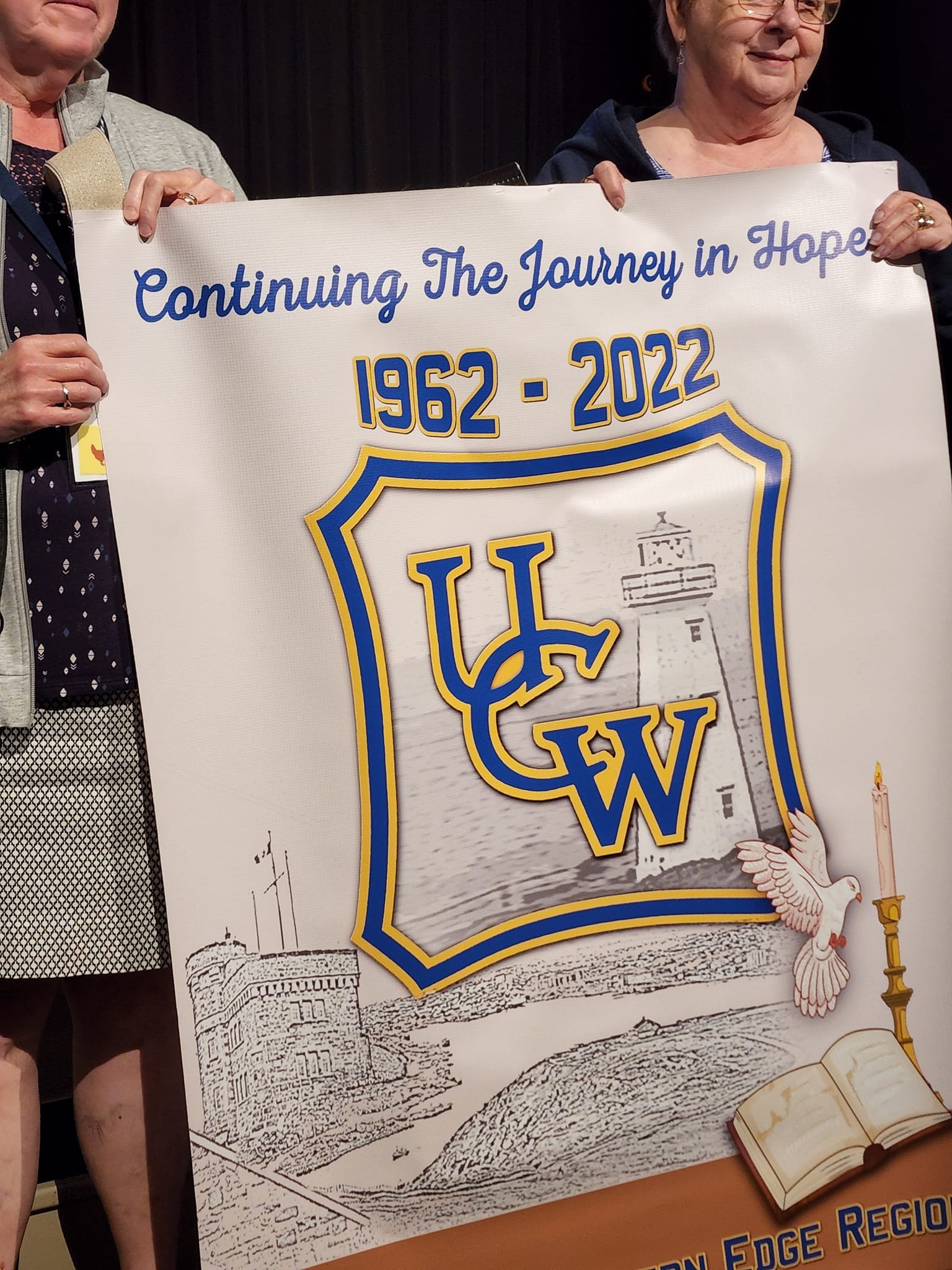
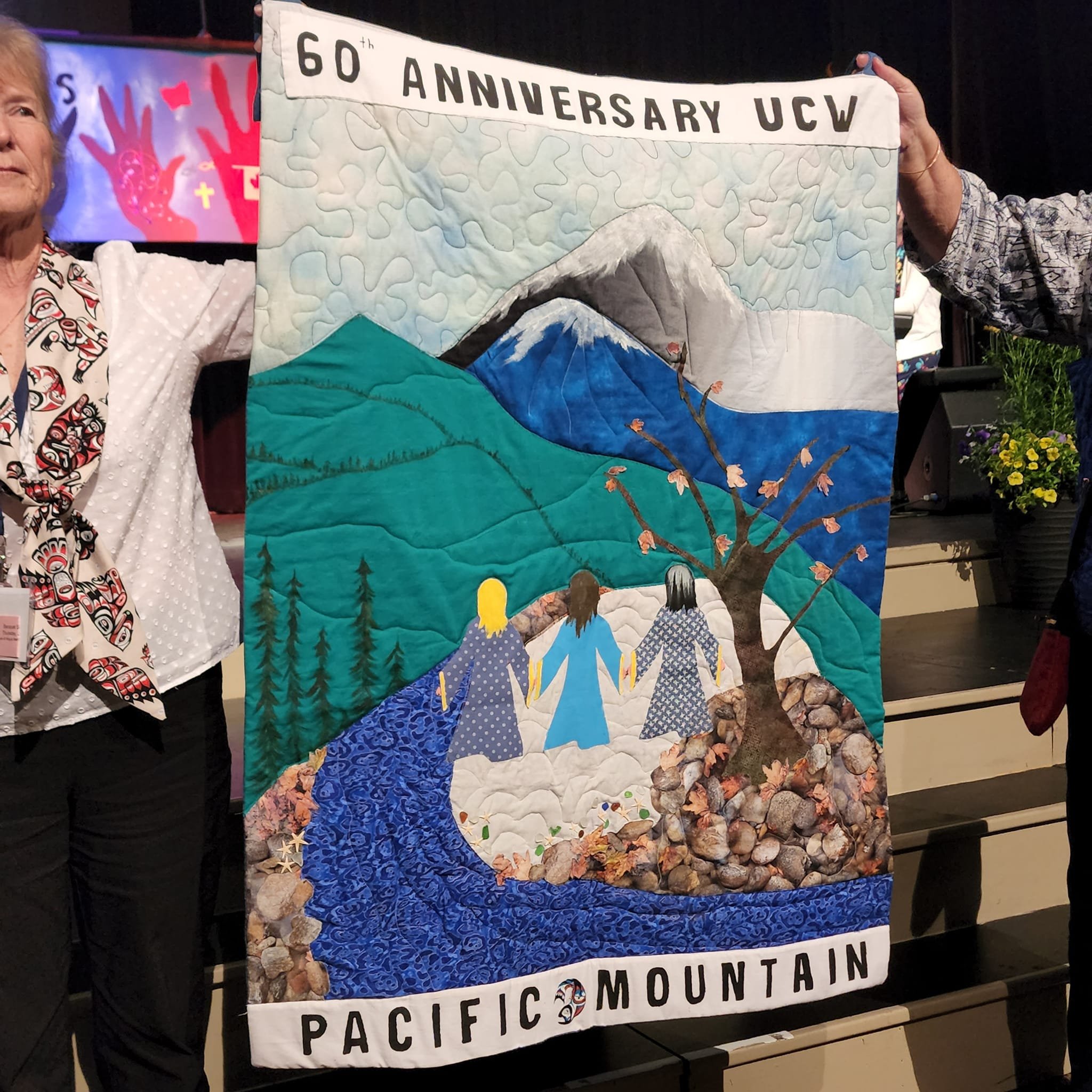

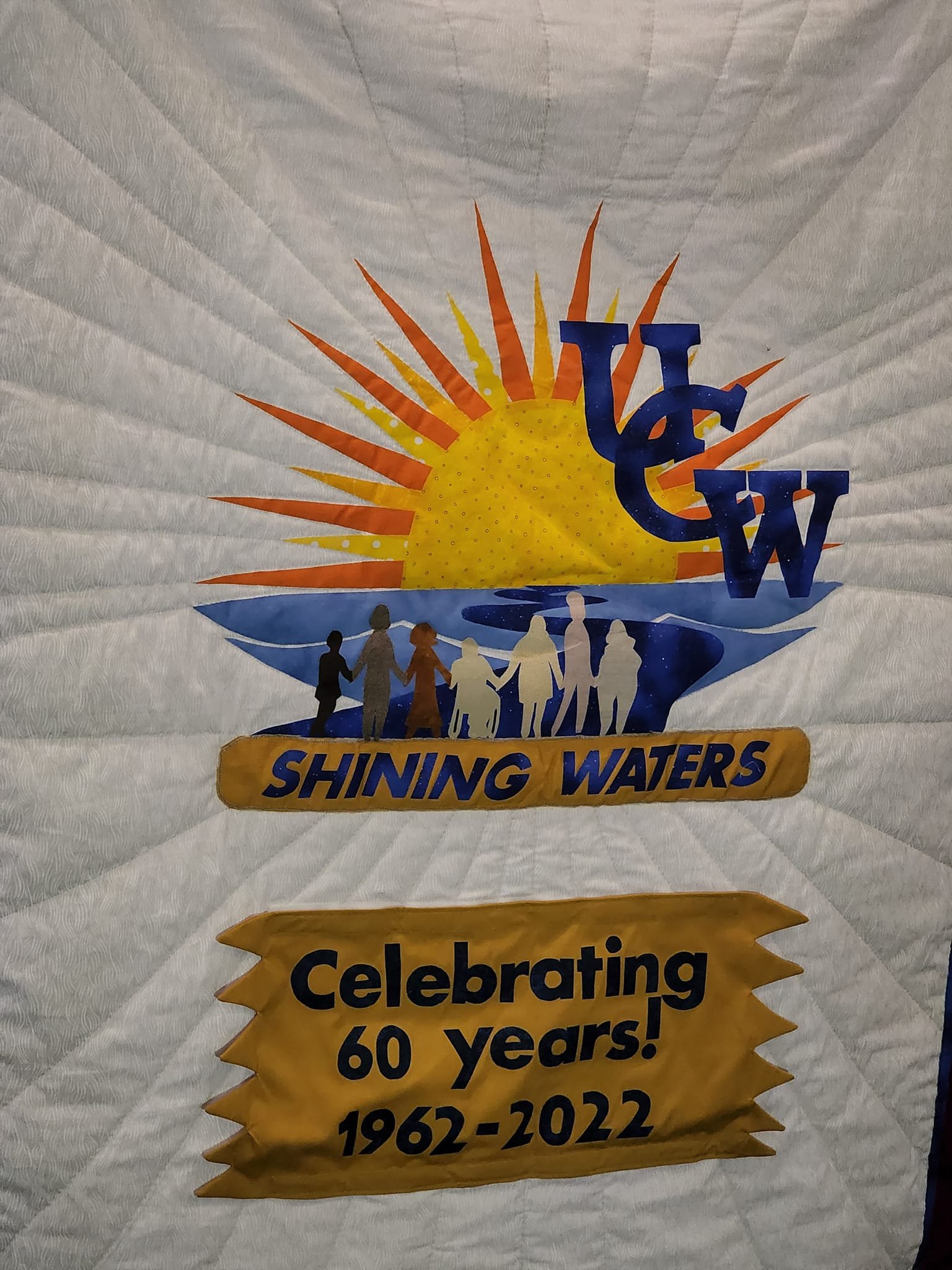
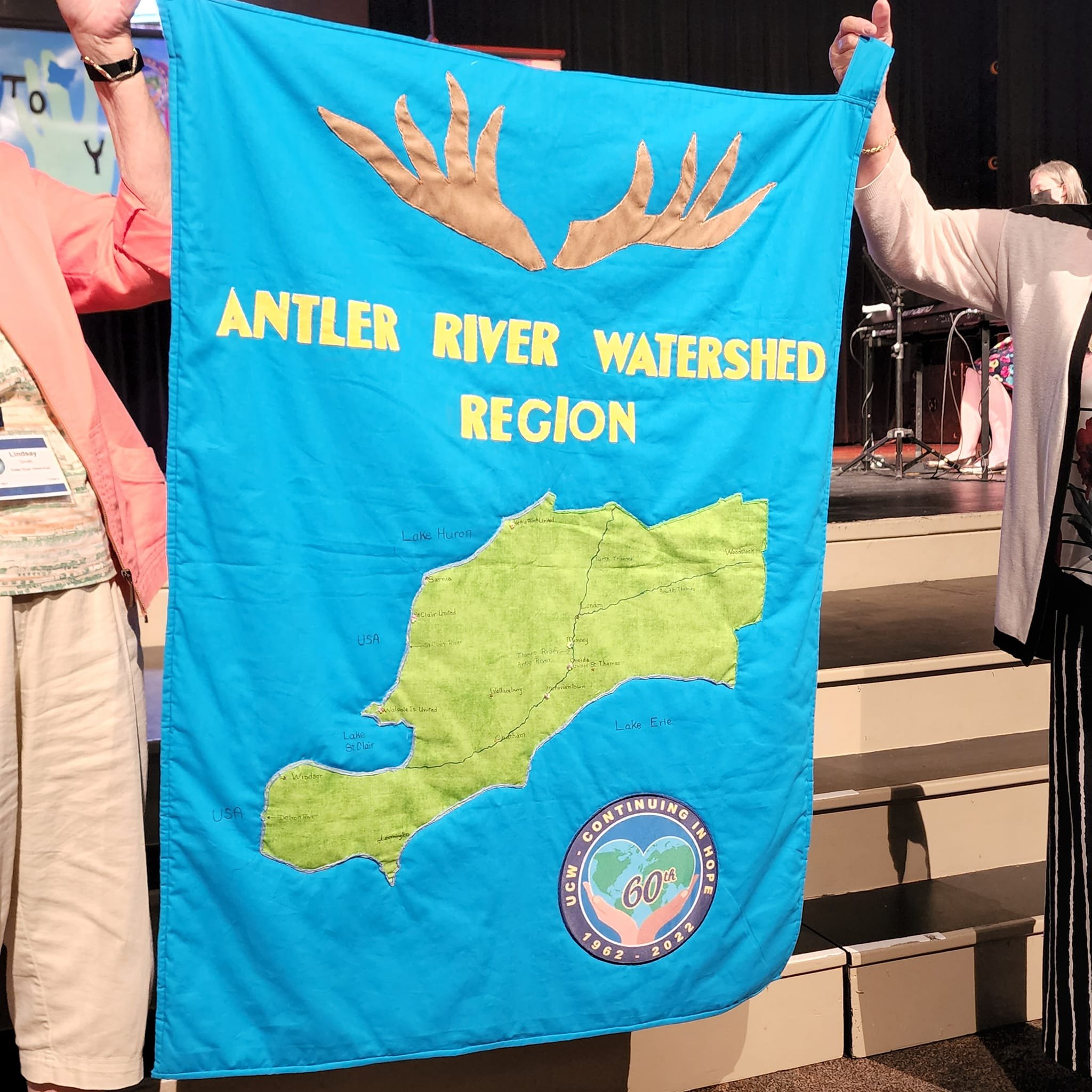
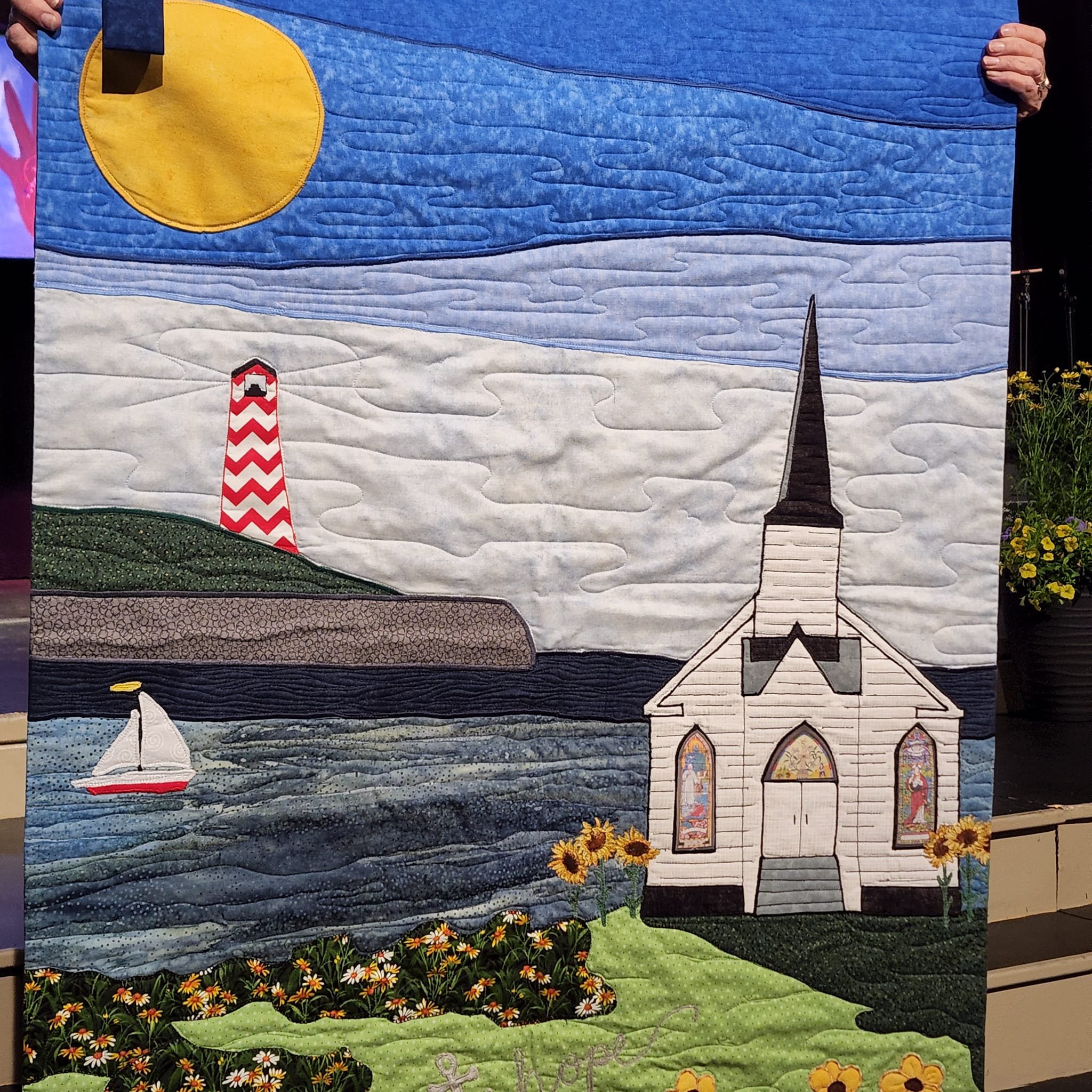
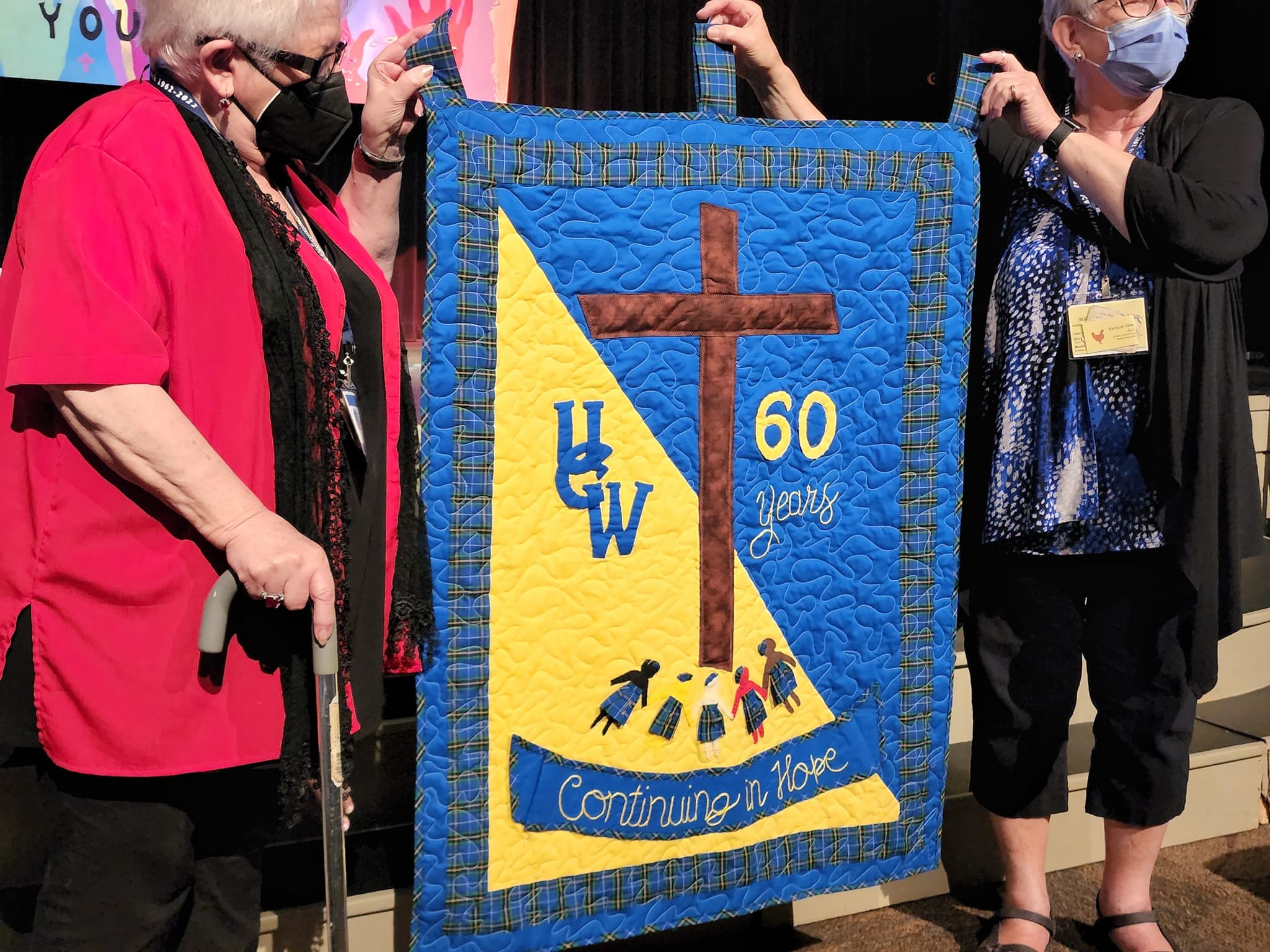
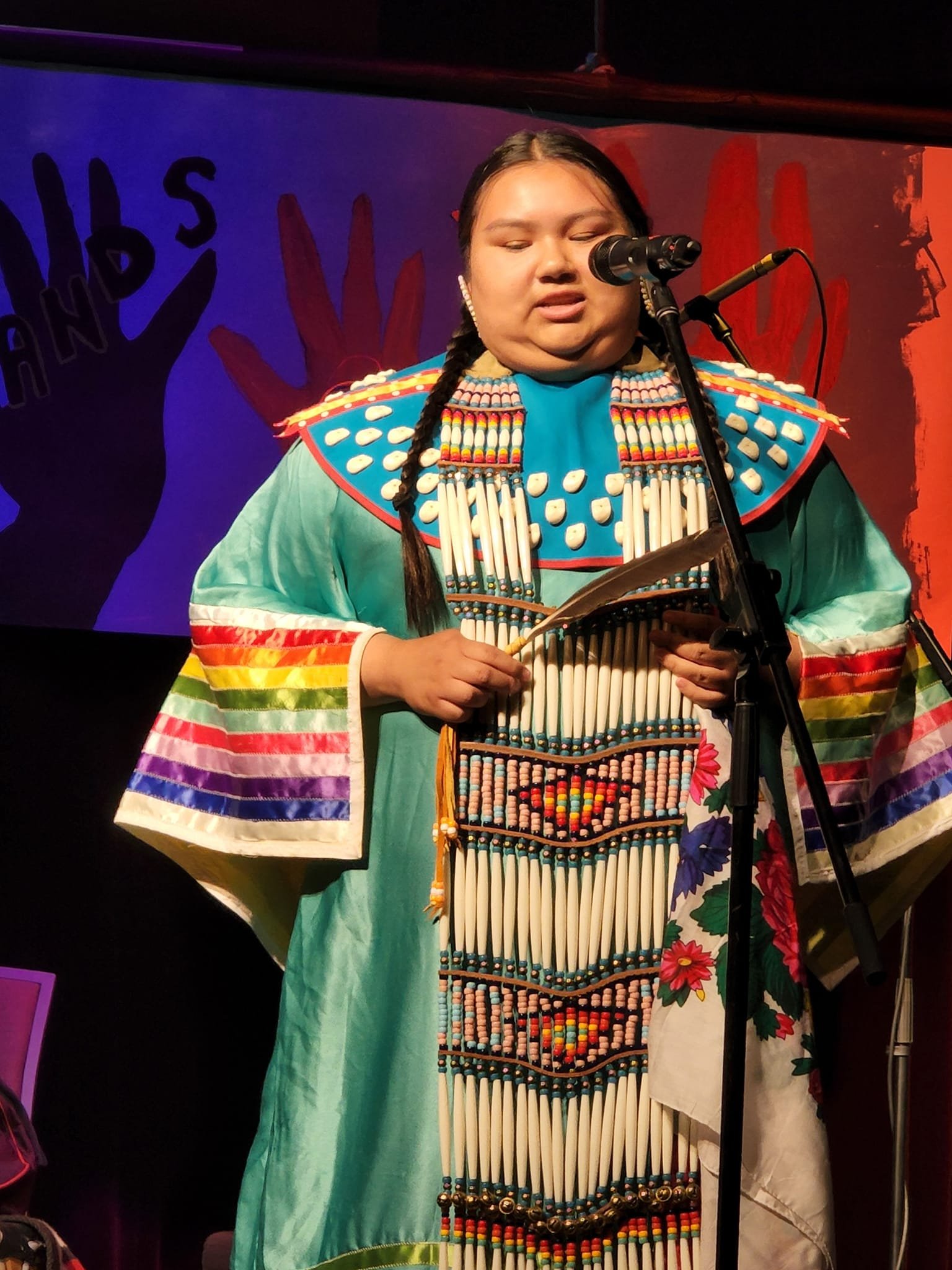
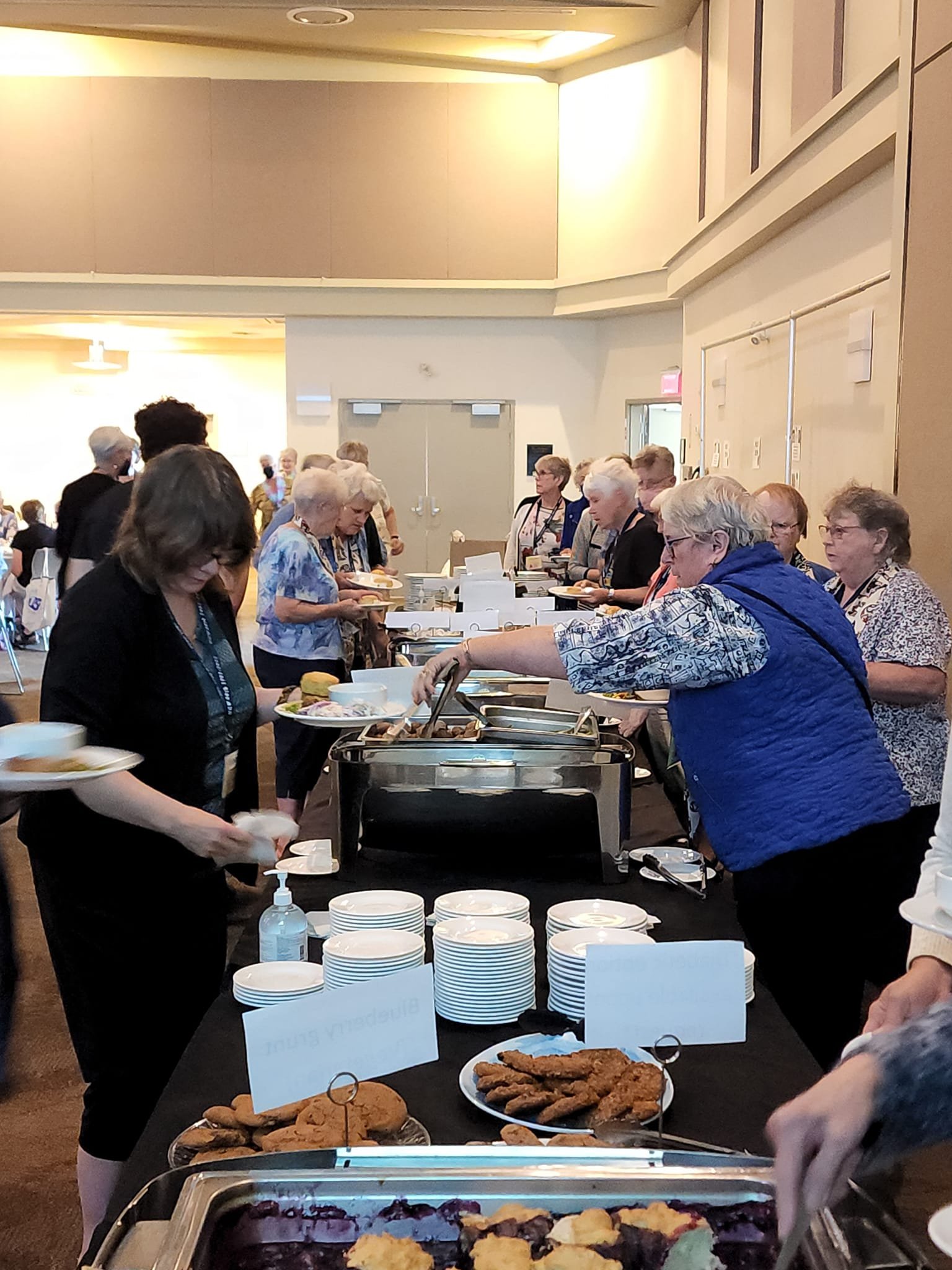
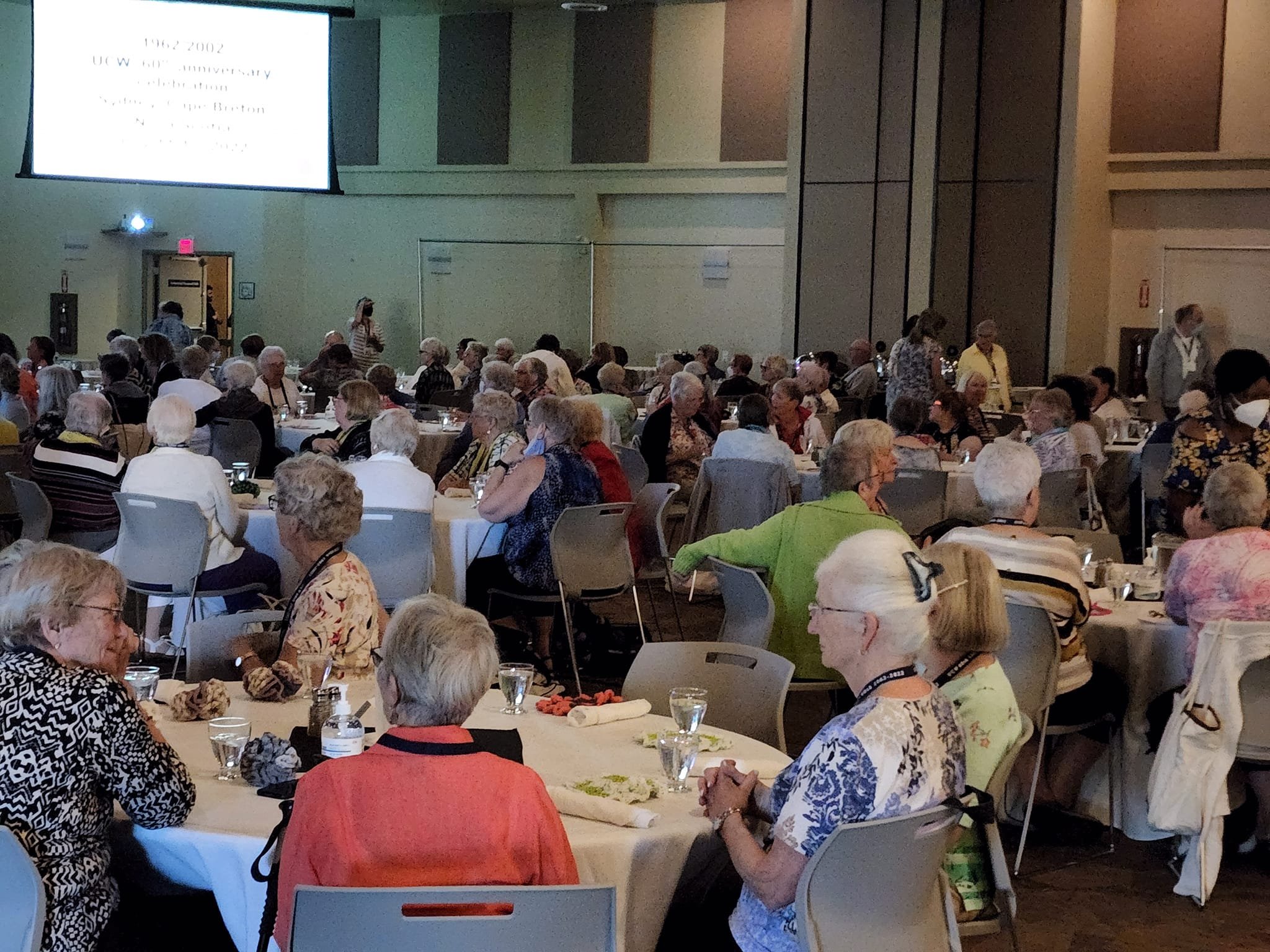
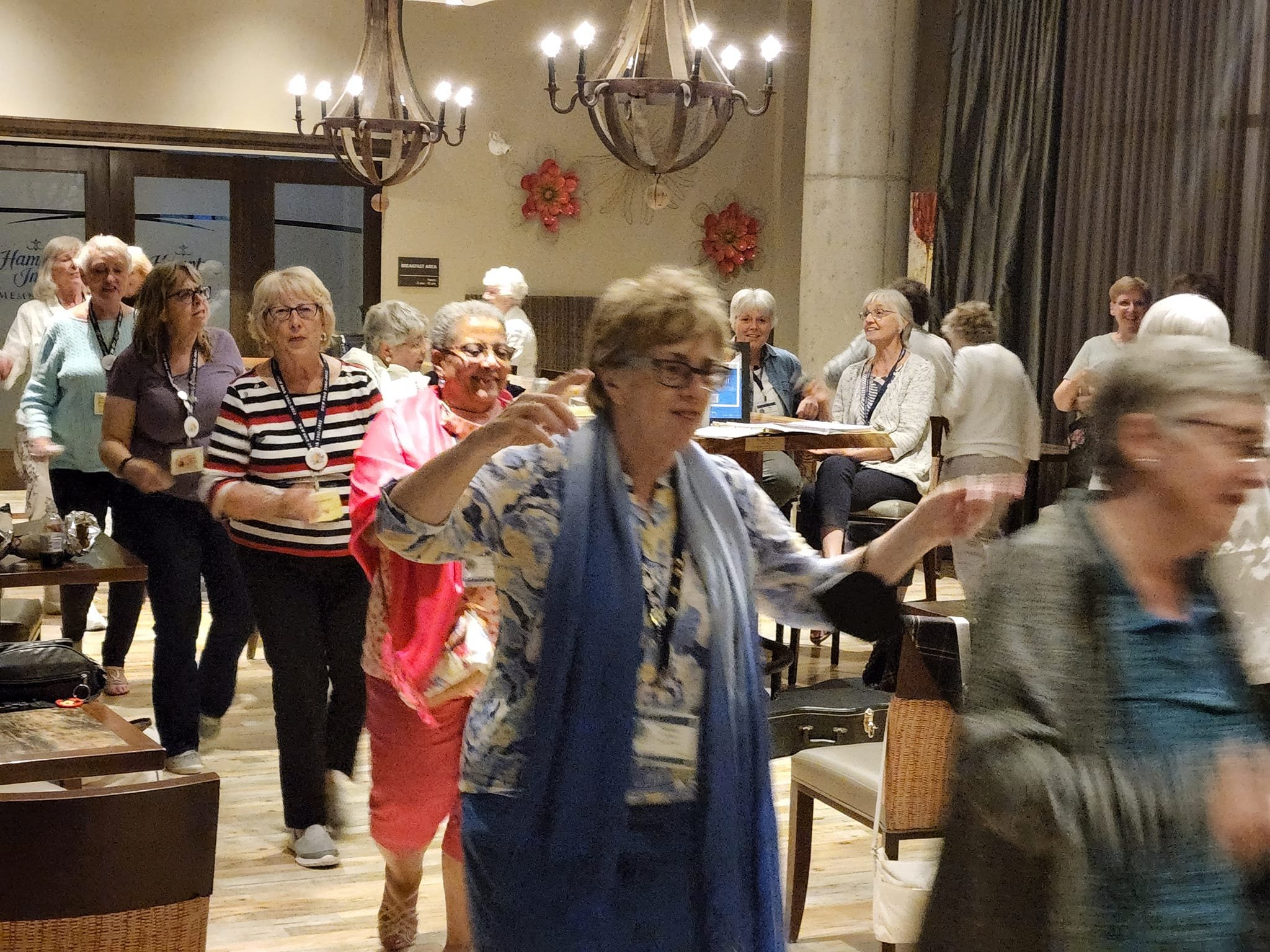
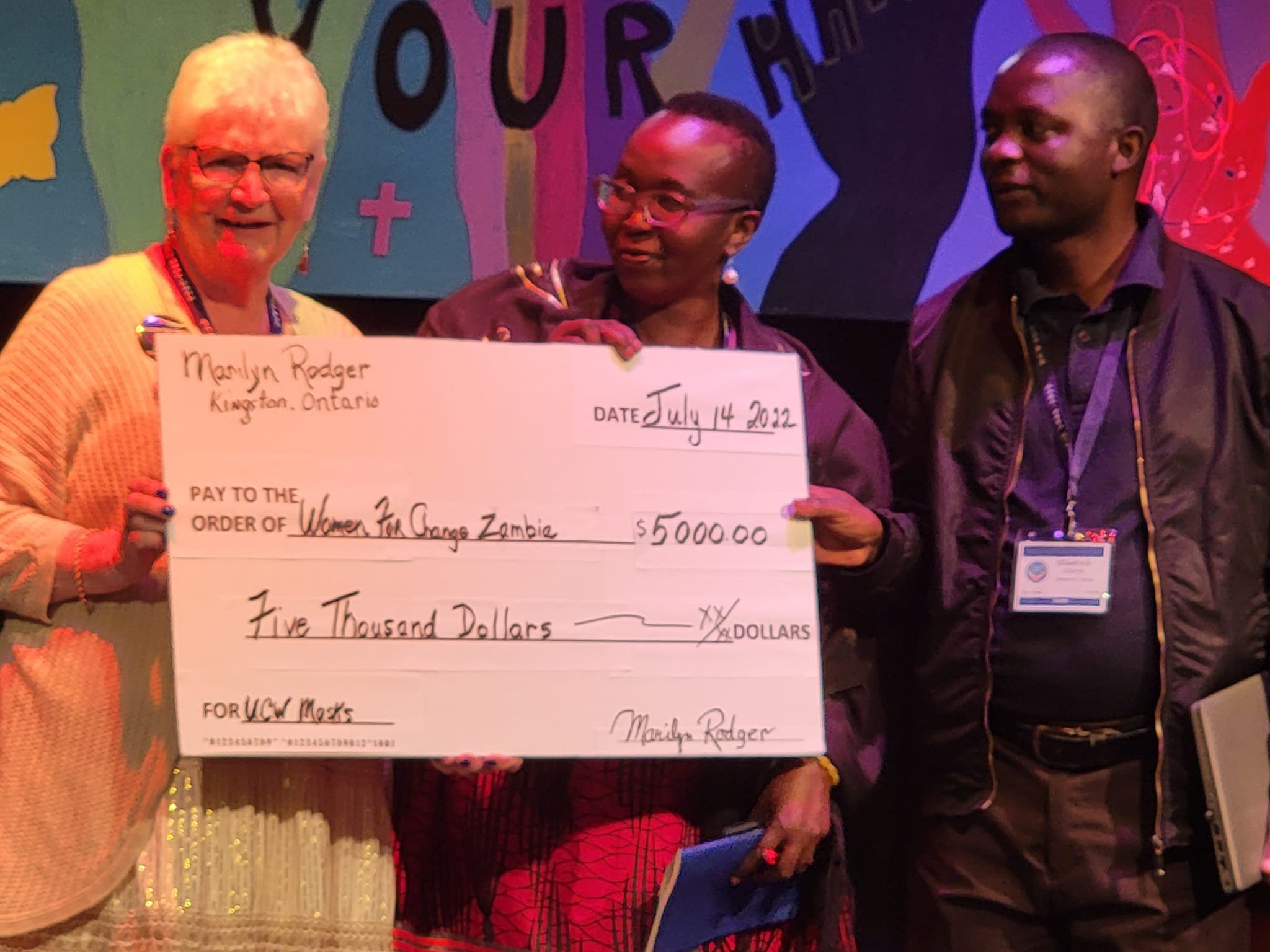
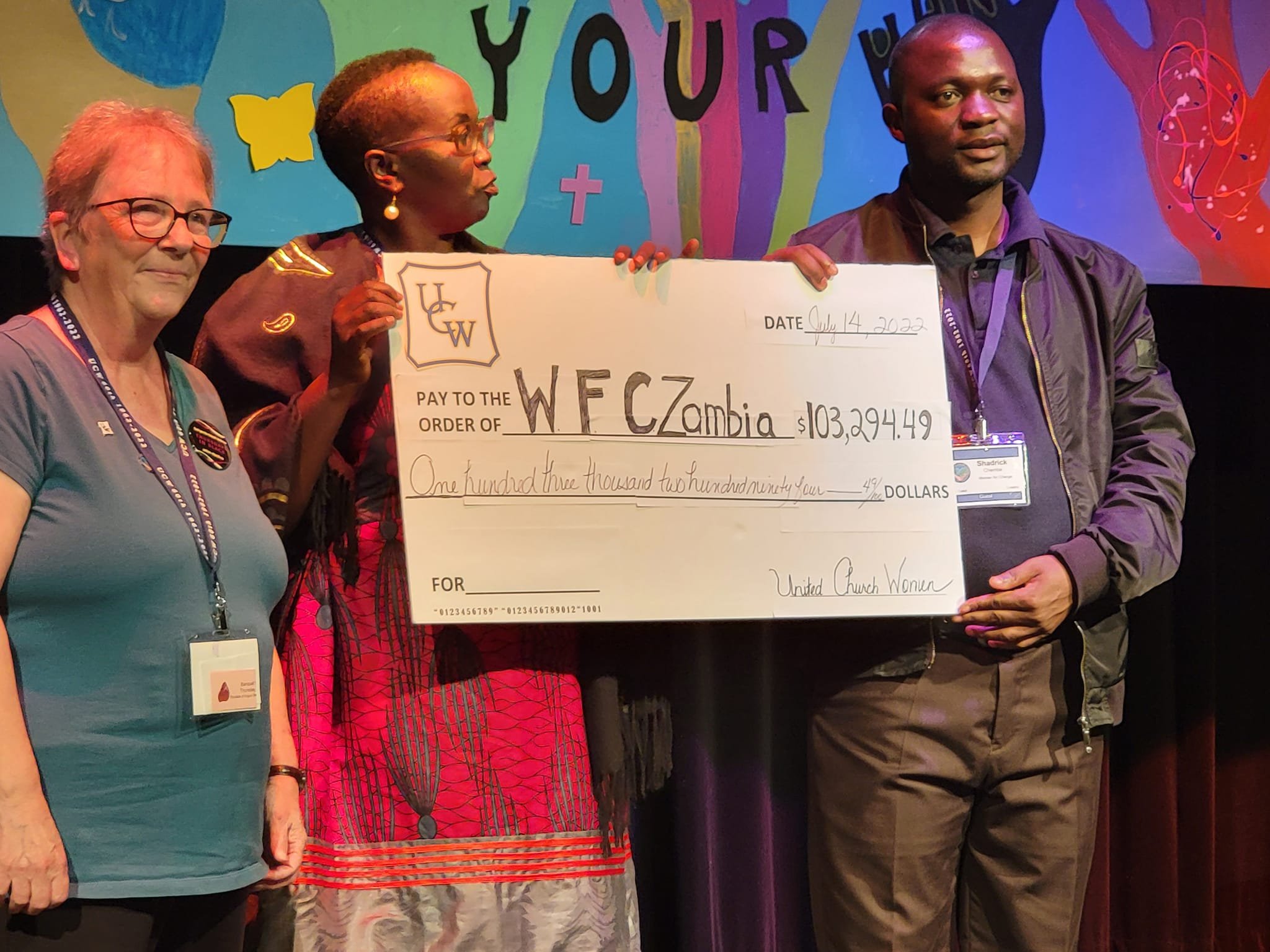
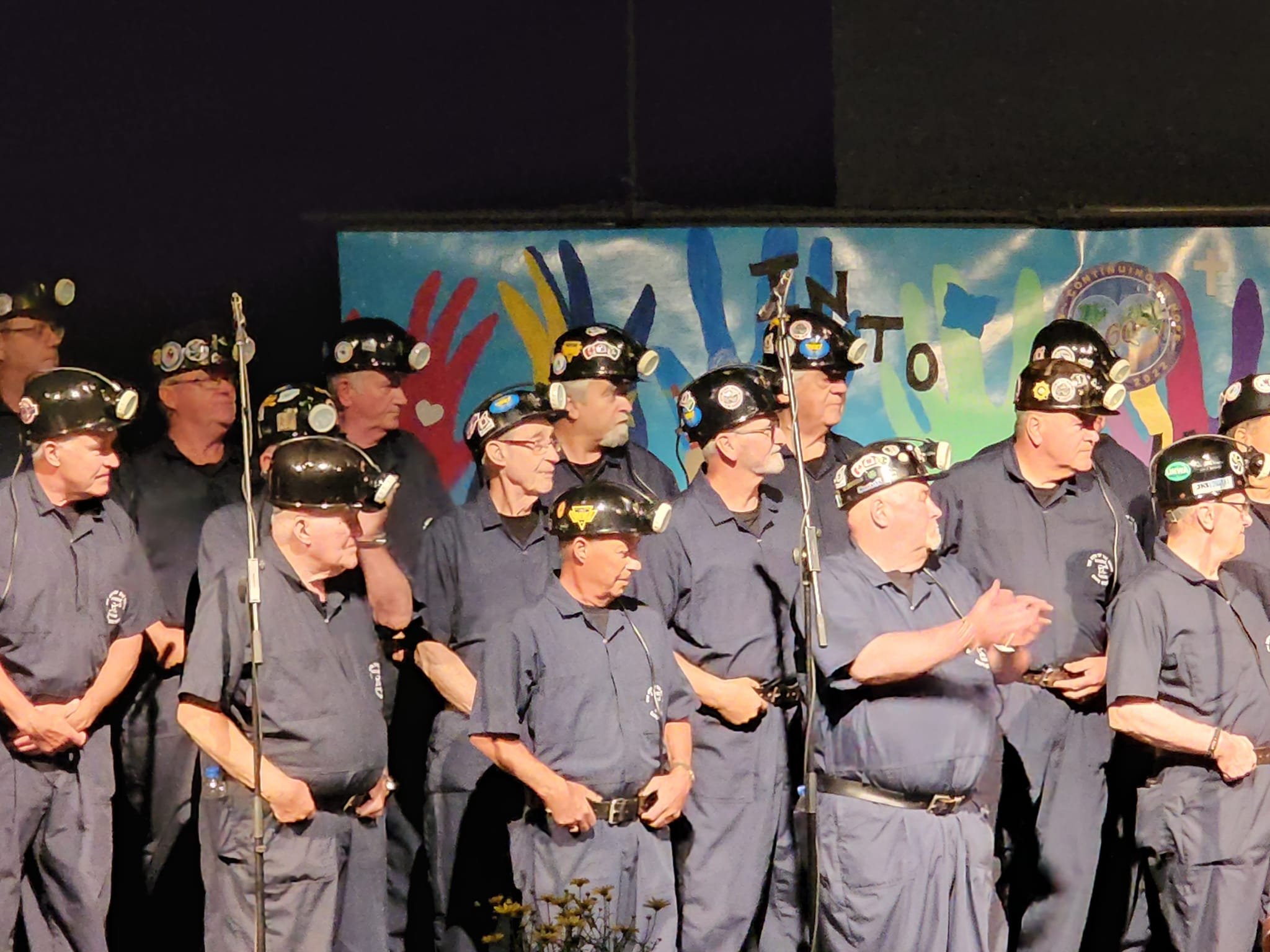
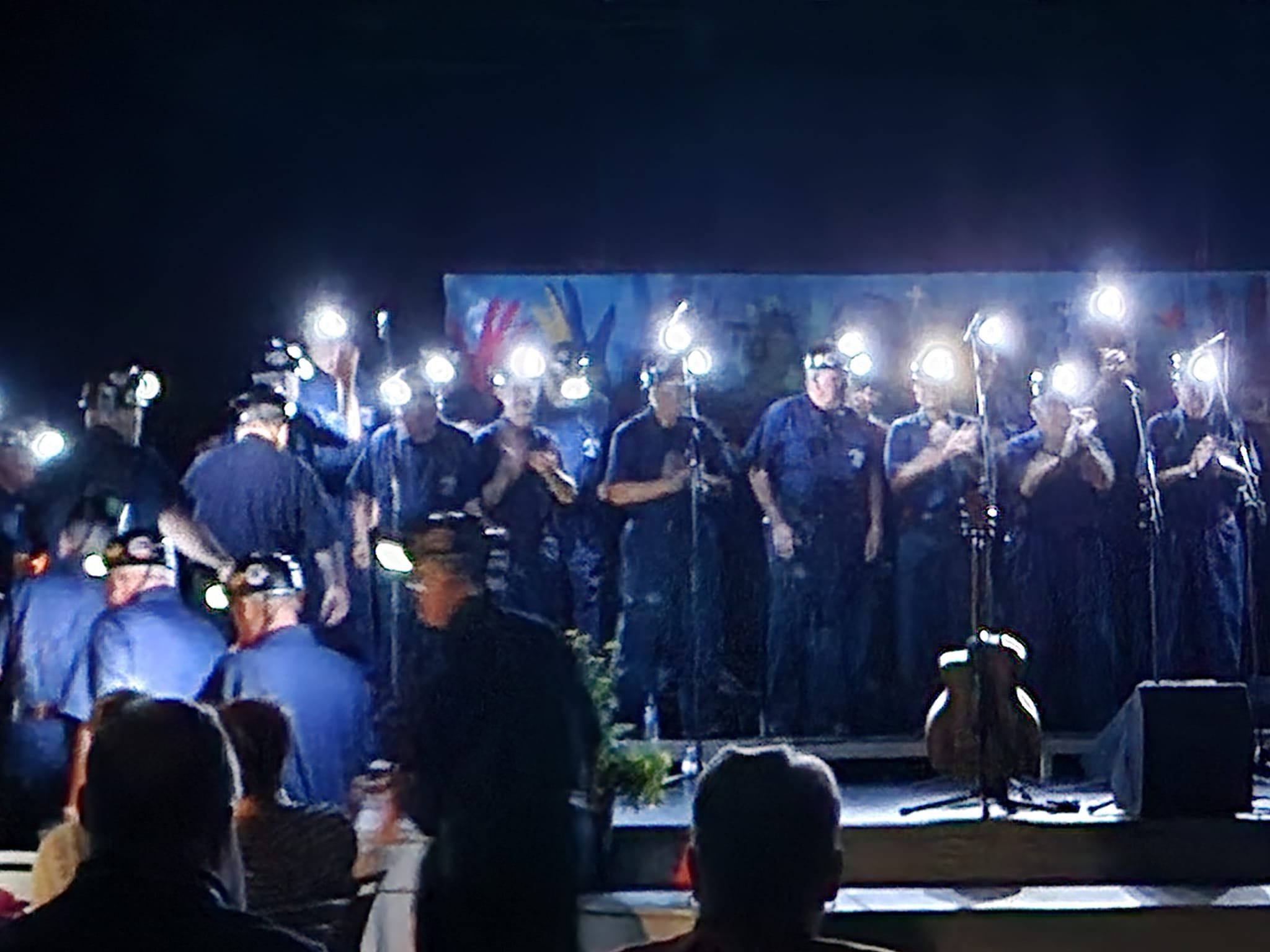
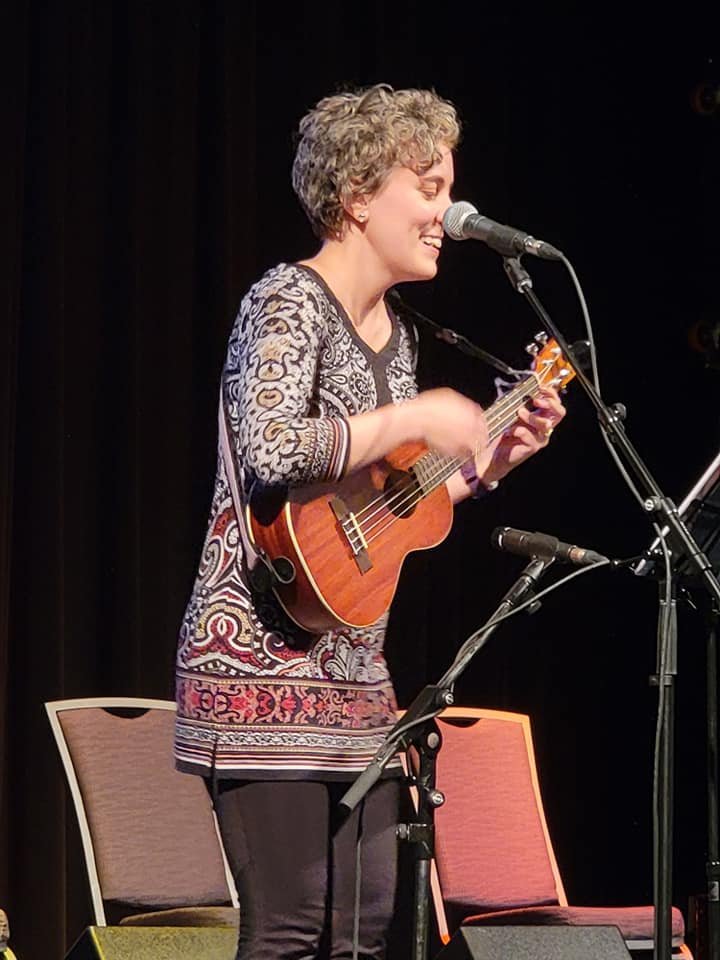
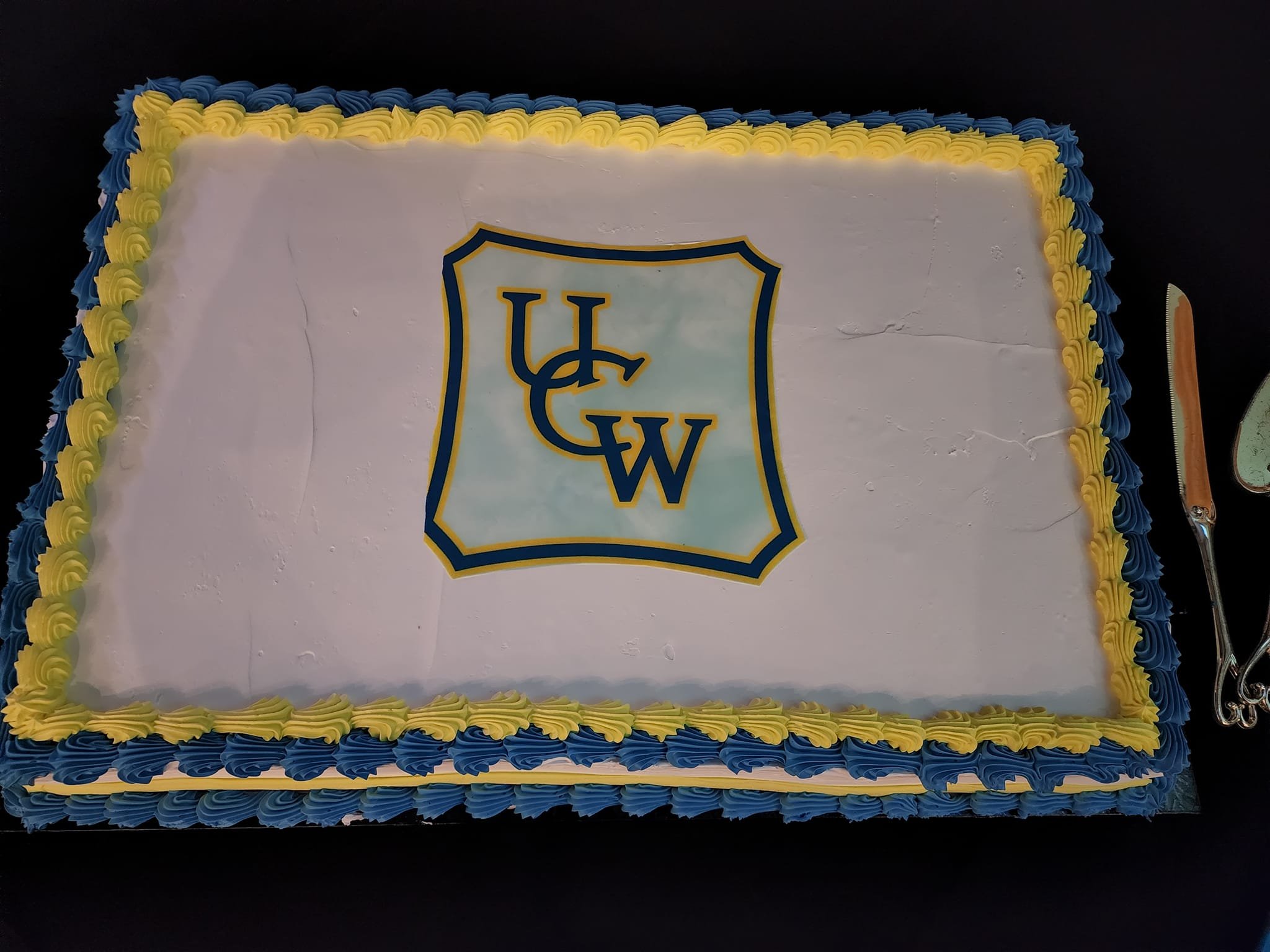
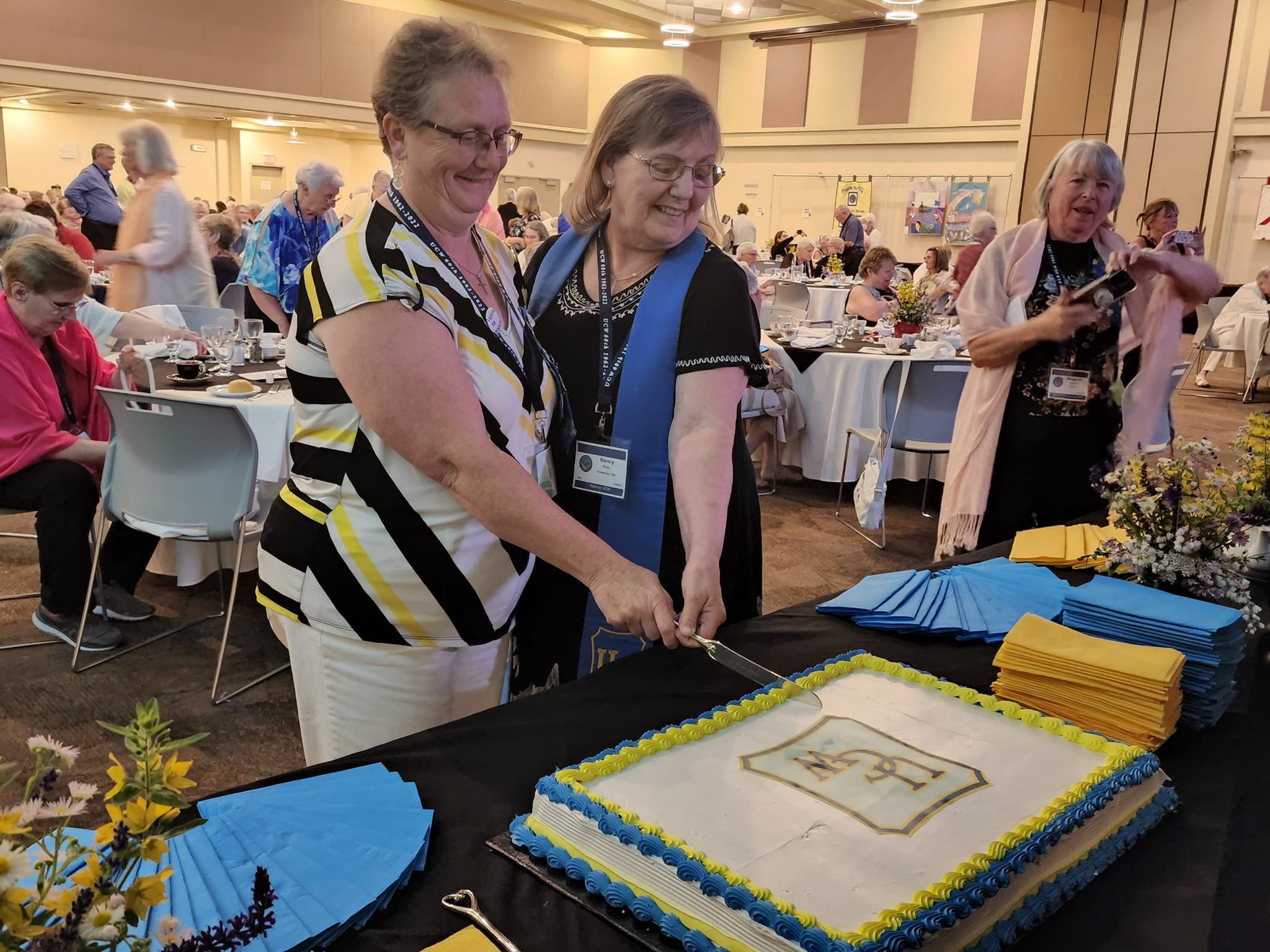
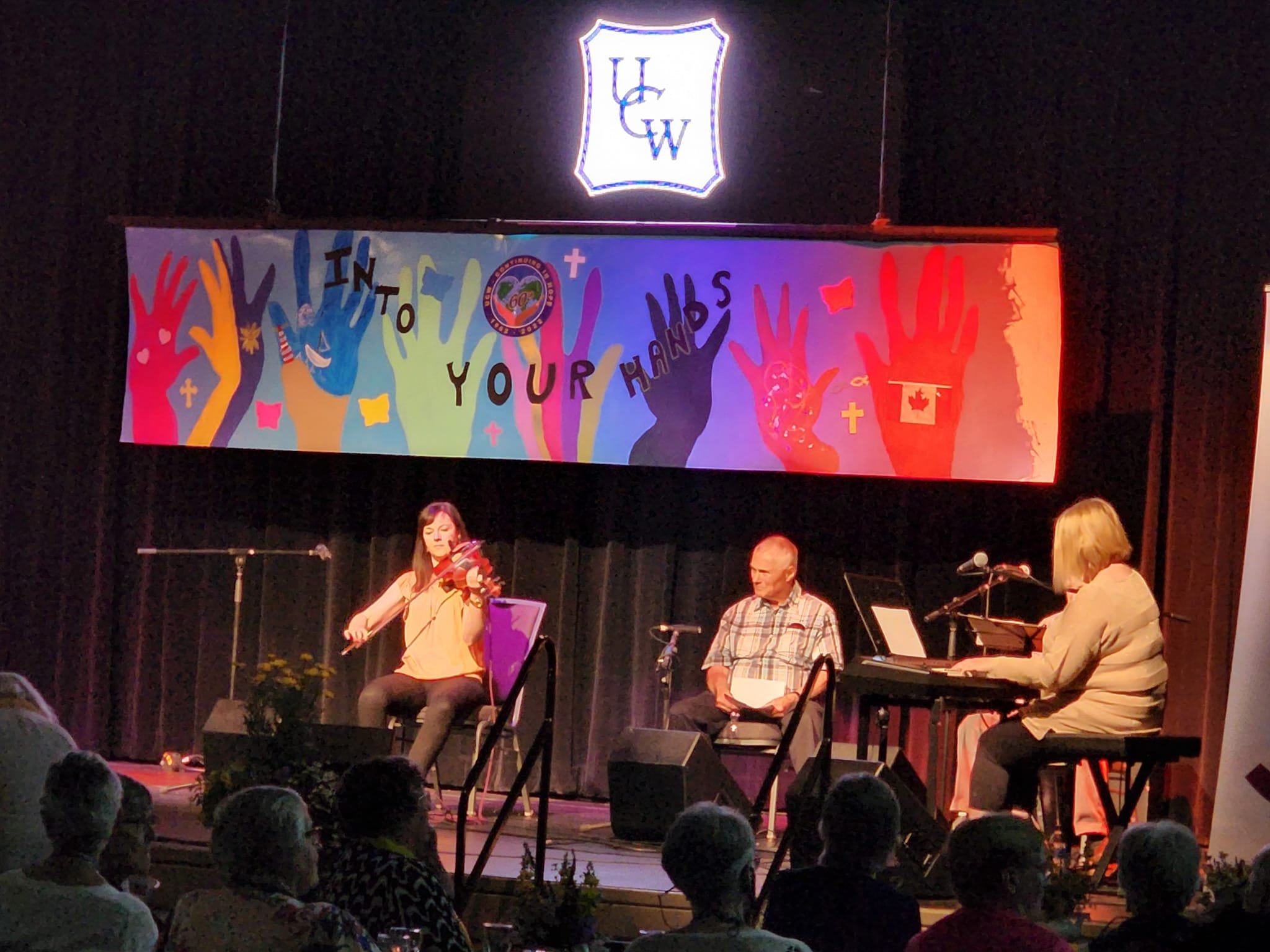
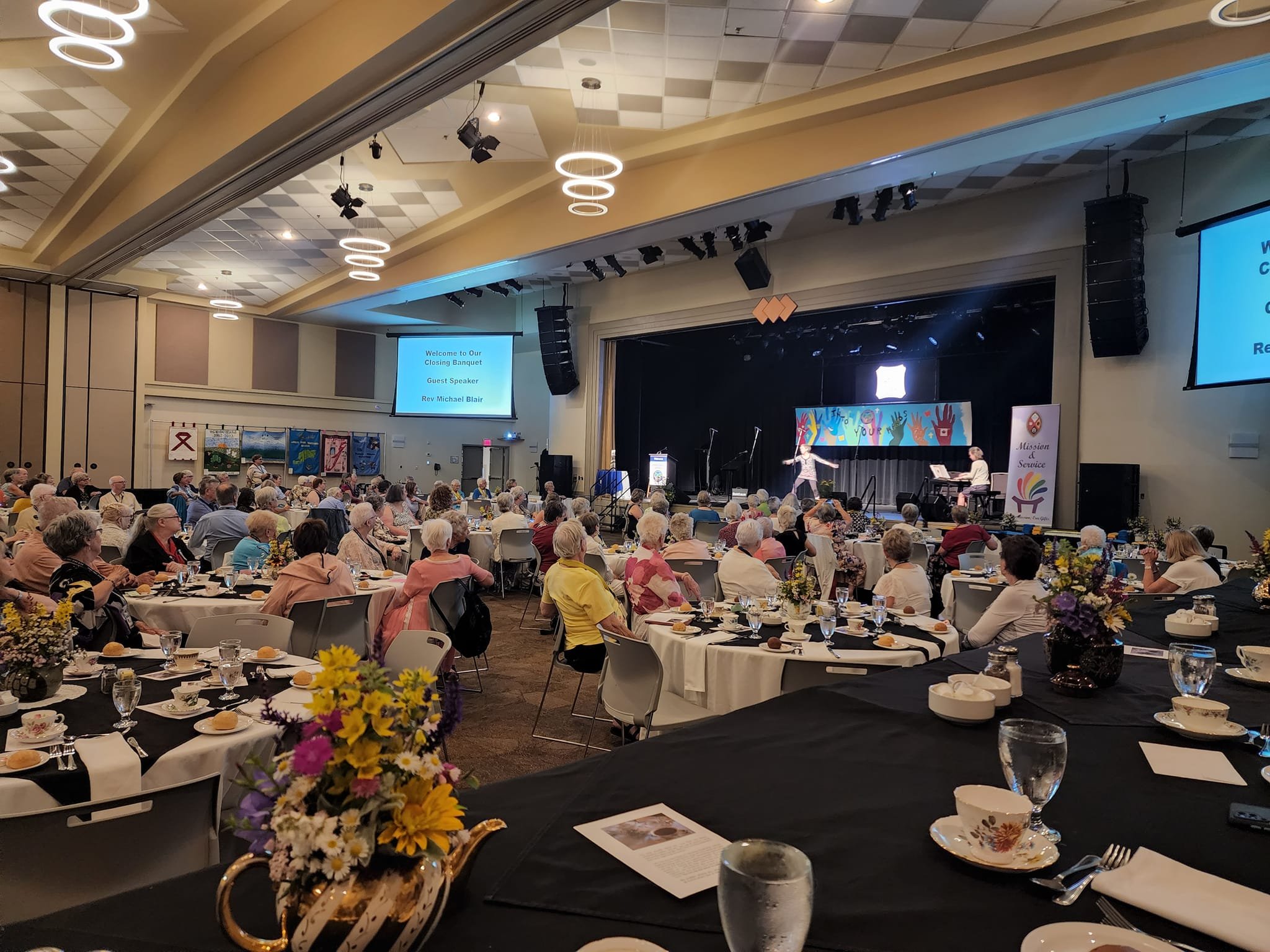
"For King and Country"
Two of our most prized possessions at SouthWest United are the framed, poster-sized documents that came to us in 2007 through the amalgamation of Verdun United with Crawford Park United. The first lists all members of the congregation of Verdun Methodist Church who signed up for service in the Great War, 1914-1918. It also indicates, in red, those who were killed.
The second is similar, listing all from Verdun United who volunteered for active service in World War II (1939-1945). This time, those who died are identified by a star beside their names.
Taking a close look at them recently, I began to wonder: who did the artwork on them? Were they designed by someone local and ordered from a local printer, or were they produced in great numbers for churches all across the country?
A Google search provided some answers about the one from the Second World War. I learned that the identical print can be found hanging in schools, churches, and civic organizations across the country. One thing I hadn’t noticed until I did some reading about these posters, was one additional name, appearing at the very bottom under a small crest that bears the Union Jack and a maple leaf. “A.J. Casson” it says.
Alfred Joseph Casson (1989-1992) was the youngest member of Canada’s Group of Seven landscape painters. What is his name doing on this patriotic print?
Well, like many artists, even very successful ones, Casson had a day job during most of his career. In 1926, a young Casson had taken a management position with Sampson-Matthews, a prominent midtown Toronto lithography and commercial art company.
According to a Maclean’s article from 2018, “In the aftermath of WWII, Casson took it upon himself to design a template for an honour scroll that could be filled out with veterans’ names from particular schools, congregations and other organizations. According to historians and Casson’s daughter Margaret, Sampson-Matthews printed these scrolls in the hundreds or perhaps even the thousands.
Read more about A. J. Casson on Wikipedia
See some of his paintings on the site of the McMichael Canadian Art Collection
ROLL OF HONOUR
So much for World War II, what about that poster from World War I?
Well for that one, I didn’t find any exact replicas in my internet search. Many churches have such memorials, but they all seem to be different. Perhaps my theory about local artists and printers is close to the truth when it comes to these scrolls. Casson would certainly have known of their existence, so perhaps they inspired him to design one to honour the dead of the war that came all too soon on the heels of the first one.
Our Roll of Honour scroll does not have a signature at the bottom, so unless we can uncover some mention of it in old papers, the artist’s identity may remain a mystery. Either way, it is a moving and quite beautiful piece of church and local history.
Next time you’re at church, why not take a moment to appreciate the sacrifices of veterans, and the contributions of artists - known and unknown - to preserving their memory.





I'll Fly Away
On Monday this week, I attended the funeral of a well respected Elder in the Mohawk community of Kanesatake.
In Indigenous communities, it is not unusual to find family members of the bereaved torn between elderly parents who choose to be part of the Christian community and their children and grandchildren who have opted to return to the traditional way of expressing their spirituality.
Christian funerals are somewhat different in Indigenous communities. There remains still the need to “wake” the deceased before the actual celebration of life ceremony. And, quite often, those who now embrace more traditional spirituality, will stay outside the service, close enough to be supportively near to the deceased and the family – but not actually participating in the prayers and hymns.
In fact, my first funeral in an Indigenous community entailed going to the home of the deceased, where the body was on display, and sitting in silence for what seemed like hours before offering prayer. It was simple, personal and real. Something our grandparents and great grandparents would have experienced. And, traditionally, cremation is not part of the ritual.
So, why am I telling you all this? Well, for two reasons; first I guess I am feeling nostalgic and second, the joy I felt in singing “I’ll Fly Away”, a gospel hymn written by Albert E. Brumley in 1929. I think I may have been the only one in attendance who was clapping their hands in time to the music.
Many artists have recorded this hymn over the years; Johnny Cash, Reba McEntire, Alan Jackson, Allison Krauss and others. But my favourite happened in our own SouthWest several years ago at one of our concerts (perhaps the Duram County Poets?, or the Cowgirls? or any of those homegrown groups from around the Franklin/Ormstown area)……..everyone clapping and tapping their feet in time to the words.
The words sung yesterday I offer hereunder:
Some glad morning when this life is over
I’ll fly away
To a home on God’s celestial shore
I’ll fly away
I’ll fly away, oh, Glory
I’ll fly away (in the morning)
When I die, Hallelujah, by and by
I’ll fly away
When the shadows of this life have grown,
I’ll fly away
Like a bird from prison bars has flown
I’ll fly away
I’ll fly away, oh, Glory
I’ll fly away (in the morning)
When I die, Hallelujah, by and by
I’ll fly away
Just a few more weary days and then
I’ll fly away
To a land where joy shall never end
I’ll fly away
I’ll fly away, oh, Glory
I’ll fly away (in the morning)
When I die, Hallelujah, by and by
I’ll fly away
Yeah, when I die, Hallelujah, by and by
I’ll fly away
Yes, good old songs which are a source of comfort in times of need, times of craving what we have lost or what we might indeed lose.
I leave you with the following words from Ephesians 5: 19-20
"Speak to one another with psalms, hymns and spiritual songs. Sing and make music in your heart to the Lord, always giving thanks to God the Father for everything, in the name of our Lord Jesus Christ."
In peace
Pastor Beryl, DLM


